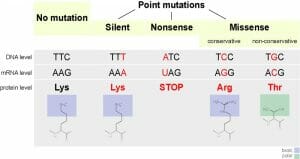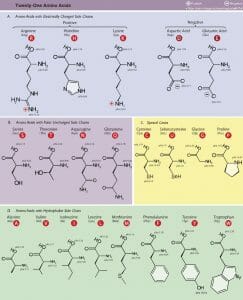Silent Mutation Definition
A silent mutation is a change in the sequence of nucleotide bases which constitutes DNA, without a subsequent change in the amino acid or the function of the overall protein. Sometimes a single amino acid will change, but if it has the same properties as the amino acid it replaced, little to no change will happen. A silent mutation can be caused many ways, but the key point is that it does not change the function of the amino acid or subsequent proteins. A silent mutation is just that: it does nothing significant, not making a sound in the orchestra of the cell.
Silent Mutation Examples
The Redundant Genome
The DNA is read in units of three nucleotides, called codons. Each codon specifies a certain amino acid, with a few reserved as stop and start signals. Sometimes, different codons specify the same amino acid. This redundancy allows a flexibility in the genetic code. This means that a silent mutation usually goes completely unnoticed. You can see a typical silent mutation in the graph below.

Here, a silent mutation is compared with both a nonsense mutation and a missense mutation. The silent mutation, which is an actual change at the DNA level from a thymine to a cytosine. This mutation could have been caused by a mistake in DNA replication, or from some sort of repair that happen after the DNA was damaged. Regardless, both of these three nucleotide codons tell the ribosome and machinery within to attach a lysine amino acid.
In this case, the entire structure of the protein will remain the same regardless of the silent mutation. With the exact same amino acid structure, the protein will function no differently unless it is placed in a different environment. A silent mutation can also happen at the protein level, with no functional effect on the protein.
Amino Acid Groups
The 4 nucleotides, in groups of three codons, can call for all 21 amino acids. Seen below, the amino acids are grouped by their structure and side chains. These features directly impact how they interact with other amino acids, and what effects they have on molecules in the environment.
A silent mutation, which could easily include more than one nucleotide, could easily change an entire amino acid, or even series of amino acids. If a serine changed into a threonine, the effect might be minimal. The two amino acids are in the same category and are very similar shapes. This means that they will have a similar chemical reaction on the molecules around them. This will influence the shape and effect of the total protein. If the effect is negligible, the change is considered a silent mutation.
Place within Protein Structure
Several amino acids can be key to the entire structure or functionality of a protein. Many proteins have an active site, to which other molecules must bind. This site is constructed from a specific sequence of amino acids. When folded just right, certain amino acids and their side chains will have the exclusive ability to interact with another molecule. If these amino acids are changed by a mutation, the functionality of bonding may be seriously impaired. This can change the function or utility of a protein.
Other proteins, on the inside of the molecule, have complex structures which must be present to preform specific functions. Many proteins undergo a conformational change, which is a change in shape. This is driven by electrical stimulation or the binding of a molecule like a coenzyme or a substrate to the protein. The conformational change, literally changing the shape of the protein, can press molecules together or tear them apart. The energy supplied is dependent upon the internal structure and specific bonds within the protein. Sometimes, a single amino acid can be a key piece of this. If this amino acid is changed for a non-functional one, the mutation is not a silent mutation. The change on the inside of the protein can also affect the functionality of the protein. Regardless of what a silent mutation changes, it should not change the functionality of the resulting protein.
Within Non-coding DNA
Many portions of the DNA are used structurally, and their full purpose is not understood. There are many cases in which parts of the DNA are vastly different between individuals, yet their phenotypes seem the same. These changes, especially small structural changes in the DNA, do not become significant until they begin to change the interaction of the coding DNA with the environment. A silent mutation could easily happen in these areas without notice, yet over time many mutations may begin to change a population.
Bacteria, interestingly, usually have a single circle of DNA, which carries all the information they need. By contrast, the human genome is separated on multiple chromosomes, which are bundled and managed by specialized proteins so they can be wound up during cell division. One hypothesis as to how this much more complex DNA came about was that certain silent mutations began forming structures of DNA. In a more compact genome, more information can be stored, which may have led to the complexity of life from single celled organisms to more complex forms. The folding and protection of various parts of DNA is part of normal cell differentiation in eukaryotes. Supposedly, these could have arisen through silent mutation until they became useful and were selected for.
Quiz
1. One of the following examples includes a silent mutation. Which one?
A. A sunbather forgets to put sunscreen on. The DNA within many skin cells is damaged, and several mutations happen when it is repaired.
B. In the third spot of the codon, a C mutates to a G. Both codons call for threonine amino acid
C. Due to a mutation, a changed amino acid within an enzyme cause it to slow down.
2. What is the difference between a nonsense mutation and a silent mutation?
A. Nothing, they both change protein function
B. A nonsense mutation does not create a change in the protein
C. A silent mutation does nothing, while a nonsense mutation can be significantly disruptive
3. On the inside of a protein, a mutation causes the swap of one amino acid with another. This change does not affect the internal structure of the protein, and both proteins act similarly in their roles. Which of the following represents this situation?
A. Silent mutation
B. Point mutation
C. Missense mutation
References
- Hartwell, L. H., Hood, L., Goldberg, M. L., Reynolds, A. E., & Silver, L. M. (2011). Genetics: From Genes to Genomes. Boston: McGraw Hill.
- Lodish, H., Berk, A., Kaiser, C. A., Krieger, M., Scott, M. P., Bretscher, A., . . . Matsudaira, P. (2008). Molecular Cell Biology (6th ed.). New York: W.H. Freeman and Company.
- Nelson, D. L., & Cox, M. M. (2008). Principles of Biochemistry. New York: W.H. Freeman and Company.

